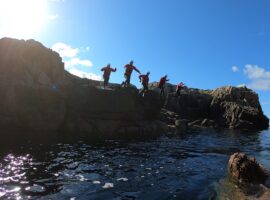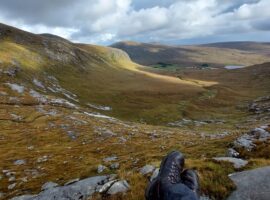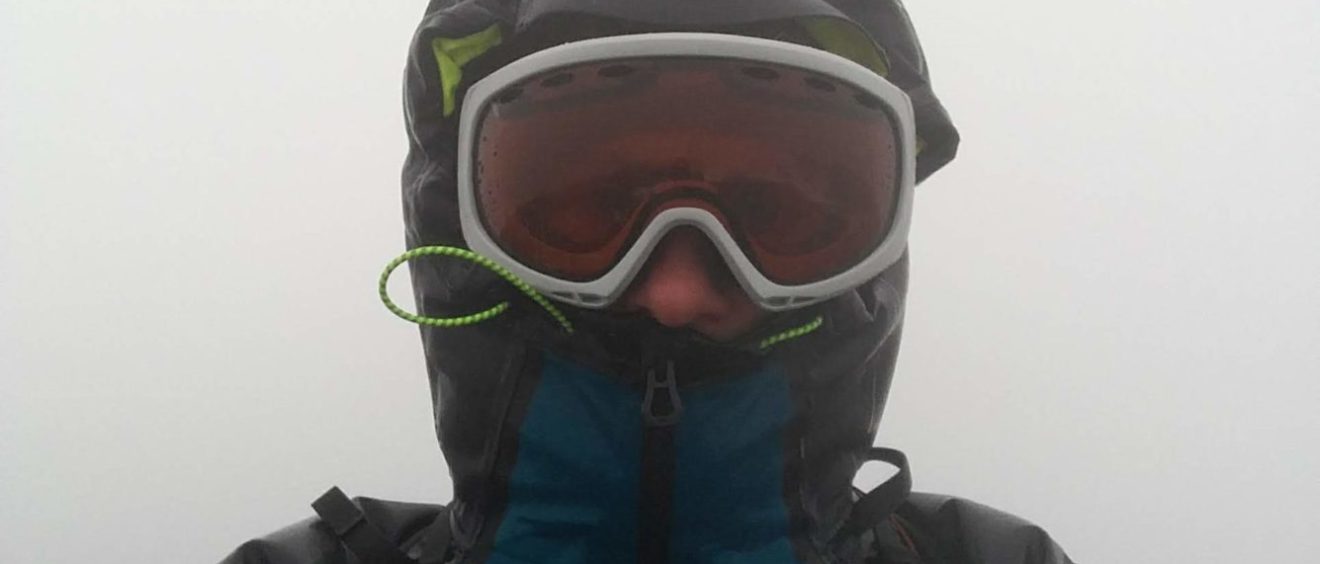
No such thing as BAD weather!!
I’m sure you have heard the quote: “There’s no such thing as bad weather, just bad clothing!” This is so true, especially at the moment here in Ireland where it just seems to be storm after storm!
“What should I wear?” is often I question I get asked by anyone I am taking out into the mountains, and so I thought I would answer that question here with a bit of an information blog about how I keep myself dry and comfortable when I’m out adventuring in the ever changing Irish weather.
The two things that I would say are key are staying dry and comfortable. When you get wet not only can it be pretty miserable but it also reduces your ability to stay warm. Being cold and wet in the mountains is when you can easily get into trouble. Hypothermia is a very real risk, especially at this time of year with wet, cold and windy conditions. I say comfortable instead of warm, as for me personally, I find being too warm nearly worse than being cold. Comfortable is what you want to be, you use a lot of energy and generate a lot of heat just by hiking over uneven ground and so it is easy to overheat.
Before I start talking about individual items, I feel it is worth noting that when it comes to outdoor gear, price and brands do make a difference. Unlike with fashion branding, it’s not just the label you are paying the extra money for, with outdoor brands I find that the more expensive ones are so, because they are market leaders when it comes to performance and functionality. But before you go rushing out and spend hundreds on some new gear, it is worth taking into account how much use you are planning on getting out of it, if it’s just a few times a year that you’ll be out in the hills in the elements then some of the cheaper options, for example mountain warehouse, would be totally fine.
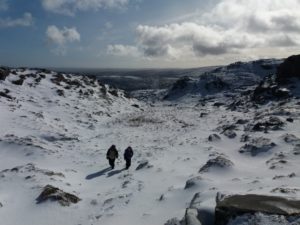
So let’s start with staying dry, the main items that help you stay dry are a good waterproof jacket, waterproof trousers and waterproof boots.
When it comes to jackets the first thing to look for is the description on it, you will find that most jackets are described as either water repellant, water resistant, shower proof or waterproof. The first three are NOT going to be waterproof, they will probably stand up to light rain, but any heavy or prolonged rainfall and you will find that the water will be soaking through the material and you will be getting wet underneath.
Not all waterproof products are equal, they come with different levels of waterproof ratings and this is measured by a means called hydrostatic head (HH). The hydrostatic head is the amount of water pressure a material can withstand before it is penetrated by the water. In a Hydrostatic Head test, the fabric is pulled tight under a 1 inch diameter tube of water. The height of the water in the tube is increased and the fabric is observed over 24hrs until the water soaks through. The level at which water starts to come through the fabric is the hydrostatic head, which is measured in mm. To be classed as waterproof a product must have a minimum HH rating of 1500mm.
So the higher the HH rating the more waterproof the jacket is, just for example, the Helly Hansen Odin jacket that I have, has a HH rating of 20,000mm! So it should keep me nice and dry in the worst of conditions (plus it looks really good too)!!
Another consideration is the breathability of the jacket, as the ability of a jacket to allow perspiration to escape is as important as not letting water in, especially if you will be doing anything energetic. If a waterproof jacket is not breathable, sweat will be unable to escape, making the wearer feel damp and think their waterproof has ‘leaked’ when in fact it’s perspiration from inside they are feeling. In addition to a breathable membrane, other features to look out for are pit zips and mesh lined pockets which can contribute to a jackets breathability.
So that’s the waterproofing and breathability of the jacket sorted, the next thing now is the type of jacket you want. There are generally two types to consider and which one is right for you depends on your own personal preference. You can either go for a hard shell jacket or a thicker padded style jacket.
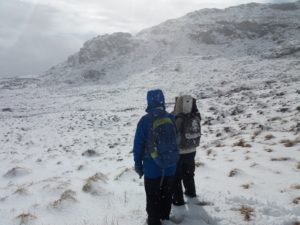
A hardshell jacket comes in two types: two layers or three layers. Two Layer Waterproof Jackets are the most common type of Waterproof Jacket. A two layer jacket combines an outer shell that is fully waterproof with an inner lining layer that prevents the deterioration of the waterproof lining by acting as a barrier to corrosion by the wearer’s movements and sweat. Three Layer Waterproof jackets are suitable for just about all weather conditions, including torrential rain. Three layer Waterproof jackets contain an external waterproof fabric layer, an internal waterproof and breathable membrane and an additional bonded protective lining. These 3 layers are bonded together to make a technically efficient 1 layer lightweight jacket.
A padded style jacket can be a 3-in-1 style or even a ski jacket. A 3 in 1 waterproof jacket consists of a waterproof outer-shell with a detachable inner fleece, softshell or padded jacket. A 3 in 1 jacket is a versatile option for all year round and ideal for changeable weather conditions. Ski jackets can be a good option if you want to feel toasty and warm (and very colourful), just make sure and check they have good ventilation options and check the waterproof rating as some can just be rated as snowproof!
For myself personally I will always choose the hard shell as it provides me with protection against the wind and rain without being too bulky causing me to overheat, and it also makes layering up under it and regulating heat easier.
The last thing to consider before you buy your perfect jacket is the fit of it. When trying on waterproof jackets always take into account the layers you will need to fit underneath. You need to be able to move your arms and shoulders especially if you are likely to be wearing a backpack or doing an activity, such as hiking or climbing, where freedom of movement will be important. Make sure the cuffs of the jacket are long enough to cover the top of your hand to help stop rain entering and soaking your arms.
The length of the jacket is also an important consideration. Always make sure the jacket is long enough to cover your lower back even when you lift your arms up. Shorter length waterproof jackets can often have a longer back so there won’t be a gap between your trousers and the jacket should it ride up, there’s nothing worse than thinking you’re nice and toasty and dry only then to feel some icy drops of water soaking in under your trousers! Finally you want to make sure the hood is a good fit for the intended use: will you need it to go over a helmet? Is the hood adjustable so you can tighten it in if it’s windy and will it protect you’ll whole head or will you find the rain getting on to your forehead and running down under the collar!
I hope this has helped in giving you a good idea of what to look for in a jacket, I’ll be moving on to waterproof trousers, hiking boots and layering up in the next blog post.


